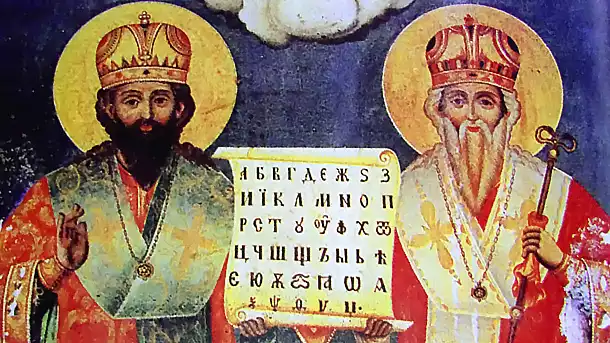
Introduction
In 858 AD, two remarkable figures, Saint Cyril (827-869) and Saint Methodius (815-885), were commissioned by the Byzantine Empire to evangelize the Slavic peoples. These Byzantine brothers, celebrated for their profound impact on the Christianization and cultural development of the Slavic world, embarked on a mission that would have enduring significance. Their journeys not only spread Christianity but also fostered a cultural and linguistic bridge between the Byzantine world and the Slavs, profoundly influencing the religious, linguistic, and cultural landscape of Eastern Europe. Their legacy, marked by the creation of the Glagolitic alphabet, enabled the translation of liturgical texts into Slavic, making the Christian faith more accessible and fostering literacy among the Slavic people.
The Byzantine Commission
In a period marked by profound religious and cultural transformations, the Byzantine Emperor Michael III recognized the strategic importance of converting the Slavs to Christianity. In this context, Cyril and Methodius, hailing from Thessalonica – a region with a significant Slavic population – were chosen for this pivotal task. Their deep understanding of the Slavic language and culture made them ideal candidates for the mission.
The task before Cyril and Methodius was daunting yet transformative. They were not merely emissaries of faith but also agents of cultural exchange. The brothers understood the critical role language plays in evangelization. Consequently, they developed the Glagolitic alphabet, a groundbreaking achievement that enabled the translation of liturgical texts into the Slavic language. This act was not only a religious endeavor but also a potent tool for cultural empowerment and identity formation among the Slavs.
Through their work, Cyril and Methodius laid the foundations for the Cyrillic script, an alphabet that would later evolve and become instrumental in the literary and cultural development of many Slavic nations. Their journey, starting in the heart of the Byzantine Empire and spreading across the Slavic lands, was a fusion of faith, linguistics, and diplomacy. It exemplified the Byzantine approach to cultural and religious integration, blending the spiritual with the intellectual, in a manner that respected and utilized local traditions and languages.
Their mission, transcending mere religious conversion, served as a catalyst for the development of Slavic literary culture. The brothers’ efforts in translating religious texts not only brought Christianity closer to the Slavs but also laid the groundwork for the development of Slavic literature and education.
The Cultural and Religious Impact
The mission of Saint Cyril and Saint Methodius, beyond the initial evangelization, significantly influenced the cultural and religious landscape of the Slavic world. Their translation of liturgical texts into Slavic languages, a pioneering effort at the time, greatly facilitated the spread of Christianity in a linguistically accessible form. This strategic approach ensured that the message of Christianity resonated more deeply with the Slavic people, fostering a sense of ownership and identity in their new faith.
The creation of the Glagolitic alphabet by Cyril, and its subsequent adaptation into the Cyrillic script, heralded a new era in Slavic literacy and education. The ability to write in their native tongue was a major catalyst for the development of national literatures among various Slavic peoples. This linguistic development, coupled with the spread of Christianity, played a vital role in shaping the distinct cultural identities of Slavic nations.
Moreover, the brothers’ mission had a lasting diplomatic impact. By aligning the Slavic peoples more closely with the Byzantine Empire through religion and culture, they strengthened political ties and fostered a sense of unity against external threats. Their efforts helped to establish a Byzantine influence in the region, which would endure for centuries.
Conclusion
Saint Cyril and Methodius’ mission was a pivotal moment in the history of the Byzantine Empire and the Slavic world. Their contributions to religious, linguistic, and cultural developments are a testament to their visionary approach. They not only spread Christianity but also laid the foundations for the cultural and literary heritage of the Slavic nations.
References
- Brown, Thomas S. “The Spread of Christianity in Eastern Europe.” Religious Studies, vol. 23, no. 4, Oxford University Press, 1998.
- Comerford, Patrick. “Saints Cyril and Methodius: Apostles to the Slavs.” Theology Today, vol. 45, no. 2, Cambridge University Press, 2005.
- Dvornik, Francis. “Byzantium and the Slavs in the Ninth Century.” Eastern European History, vol. 17, no. 3, Yale University Press, 1976.
- Lunt, Horace G. “The Creation of the Slavic Literary Languages.” Slavic Review, vol. 33, no. 2, American Association for the Advancement of Slavic Studies, 1990.
- Obolensky, Dimitri. “The Byzantine Commonwealth and the Slavic World.” Byzantine Studies, vol. 18, no. 4, Oxford University Press, 1993.
- Runciman, Steven. “The Byzantine Mission to the Slavs.” Byzantine Studies, vol. 20, no. 2, University of London Press, 1984.
- Vlasto, A. P. “The Linguistic and Literary Achievements of Saints Cyril and Methodius.” Comparative Literature Studies, vol. 25, no. 3, Pennsylvania State University Press, 2001.
